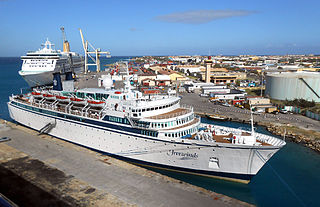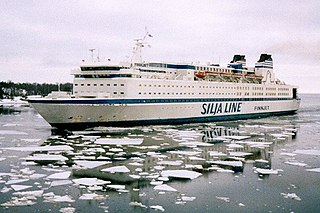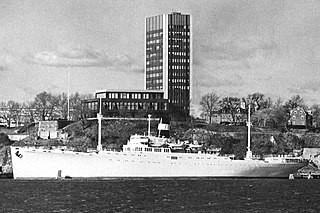
Cruise ships are large passenger ships used mainly for vacationing. Unlike ocean liners, which are used for transport, cruise ships typically embark on round-trip voyages to various ports of call, where passengers may go on tours known as "shore excursions". On "cruises to nowhere" or "nowhere voyages", some cruise ships make two- to three-night round trips without visiting any ports of call.

A visa is a conditional authorization granted by a polity to a foreigner that allows them to enter, remain within, or leave its territory. Visas typically include limits on the duration of the foreigner's stay, areas within the country they may enter, the dates they may enter, the number of permitted visits, or if the individual can work in the country in question. Visas are associated with the request for permission to enter a territory and thus are, in most countries, distinct from actual formal permission for an alien to enter and remain in the country. In each instance, a visa is subject to entry permission by an immigration official at the time of actual entry and can be revoked at any time. Visa evidence most commonly takes the form of a sticker endorsed in the applicant's passport or other travel document but may also exist electronically. Some countries no longer issue physical visa evidence, instead recording details only in immigration databases.

A passenger ship is a merchant ship whose primary function is to carry passengers on the sea. The category does not include cargo vessels which have accommodations for limited numbers of passengers, such as the ubiquitous twelve-passenger freighters once common on the seas in which the transport of passengers is secondary to the carriage of freight. The type does however include many classes of ships designed to transport substantial numbers of passengers as well as freight. Indeed, until recently virtually all ocean liners were able to transport mail, package freight and express, and other cargo in addition to passenger luggage, and were equipped with cargo holds and derricks, kingposts, or other cargo-handling gear for that purpose. Only in more recent ocean liners and in virtually all cruise ships has this cargo capacity been eliminated.
Suica is a prepaid rechargeable contactless smart card, electronic money used as a fare card on train lines in Japan, launched on November 18, 2001. The card can be used interchangeably with JR West's ICOCA in the Kansai region and San'yō region in Okayama, Hiroshima, and Yamaguchi prefectures, and also with JR Central's TOICA, JR Kyushu's SUGOCA, Nishitetsu's Nimoca, and Fukuoka City Subway's Hayakaken area in Fukuoka City and its suburb areas. The card is also increasingly being accepted as a form of electronic money for purchases at stores and kiosks, especially within train stations. As of 2018, JR East reports 69.4 million Suica UID's have been issued, usable at 476,300 point of sale locations, with 6.6 million daily transactions.

MV Freewinds is a former cruise ship operated by International Shipping Partners and owned by San Donato Properties, a company affiliated with the Church of Scientology. She was built in 1968 by Wärtsilä Turku Shipyard in Turku, Finland, for Wallenius Lines as MS Bohème for service with Commodore Cruise Line. She was the first cruise ship built in Finland. Her ownership passed to a Church of Scientology-controlled company in 1985.

SS Imperator was a German ocean liner built for the Hamburg America Line, launched in 1912. At the time of her completion in June 1913, she was the largest passenger ship in the world by gross tonnage, surpassing the new White Star liner Olympic.

MV Aurora is a cruise ship of the P&O Cruises fleet. The ship was built by Meyer Werft at their shipyard in Papenburg, Germany. At over 76,000 tonnes, Aurora is the smallest and oldest of seven ships currently in service with P&O Cruises. She officially entered service with the company in April 2000 and was named by Anne, Princess Royal in Southampton, United Kingdom. Aurora was refitted in 2014, during which the ship was the first of P&O's ships to receive an updated British Union flag design on her bow and her funnel repainted from yellow to blue.

SS France was a Compagnie Générale Transatlantique ocean liner, constructed by the Chantiers de l'Atlantique shipyard at Saint-Nazaire, France, and put into service in February 1962. At the time of her construction in 1960, the 316 m (1,037 ft) vessel was the longest passenger ship ever built, a record that remained unchallenged until the construction of the 345 m (1,132 ft) RMS Queen Mary 2 in 2004.

The GTS Finnjet was a cruiseferry, built in 1977 by Wärtsilä Helsinki Shipyard, Finland for Finnlines traffic between Finland and Germany. At the time of her delivery, Finnjet was the fastest, longest and largest car ferry in the world, and the only one powered by gas turbines. At the point of her scrapping in 2008, she remained the fastest conventional ferry in the world, with a recorded top speed of 33.5 knots.

MS Zaandam is a cruise ship owned and operated by Holland America Line, named for the city of Zaandam, Netherlands near Amsterdam. She was built by Fincantieri in Marghera, Italy and delivered in 2000. Zaandam is part of the Rotterdam class and a sister ship to Volendam, Rotterdam, and Amsterdam.

MS Westerdam is a Vista-class cruise ship owned by Holland America Line. She is the third ship of the class to be operated by the line, as well as being the third ship to bear the name Westerdam. Her sister ships are Oosterdam, Zuiderdam, and Noordam. The beginning of the four ships' names represent the four directions of the compass in Dutch.
Boarding is the entry of passengers onto a vehicle, usually in public transportation. Boarding starts with entering the vehicle and ends with the seating of each passenger and closing the doors. The term is used in road, rail, water and air transport.
A passport stamp is an inked impression in a passport typically made by rubber stamp upon entering or exiting a territory.

SS Prinz Friedrich Wilhelm was an ocean liner for North German Lloyd (NDL) from her launch in 1907 until the end of World War I. After the war, she briefly served as USS Prinz Friedrich Wilhelm (ID-4063) for the United States Navy returning American troops from France. The vessel was first chartered—and later purchased outright—by Canadian Pacific Steamships (CP) and operated under the names Empress of China, Empress of India, Montlaurier, Monteith, and Montnairn. She was scrapped in 1929.

MSC Preziosa is a Fantasia-class cruise ship owned and operated by MSC Cruises. She entered service in March 2013. She is an enhanced version of her first two class member ships, MSC Splendida and MSC Fantasia, and is identical to the previous MSC Divina. She debuted on 13 March as the fourth ship in the Fantasia class.

Regal Princess is a Royal-class cruise ship operated by Princess Cruises, a subsidiary of Carnival Corporation & plc, and is the second ship to sail for the cruise line under this name. Regal Princess, as well as her sister ship Royal Princess, were ordered on 17 February 2010 from Fincantieri and were constructed at the Fincantieri shipyard in Monfalcone, Italy, and debuted in 2014.

The Canadian Museum of Immigration at Pier 21, in Halifax, Nova Scotia, is Canada's national museum of immigration. The museum occupies part of Pier 21, the former ocean liner terminal and immigration shed from 1928 to 1971. Pier 21 is Canada's last remaining ocean immigration shed. The facility is often compared to Ellis Island (1892–1954), in terms of its importance to mid-20th-century immigration to Canada an association it shares with 19th century immigration history at Grosse Isle, Quebec (1832–1932) and Partridge Island in Saint John, New Brunswick (1785–1941). The museum began as an independent institution run by the Pier 21 Society in 1999. It became a national museum run by the Canadian federal government in 2011.
Visa requirements for crew members are administrative entry restrictions imposed by countries on members of the crew during transit or turnaround.

Automated border control systems (ABC) or eGates are automated self-service barriers which use data stored in a chip in biometric passports along with a photo or fingerprint taken at the time of entering the eGates to verify the passport holder's identity. Travellers undergo biometric verification using facial or iris recognition, fingerprints, or a combination of modalities. After the identification process is complete and the passport holder's identity is verified, a physical barrier such as a gate or turnstile opens to permit passage. If the passport holder's identification is not verified or if the system malfunctions, then the gate or turnstile does not open and an immigration officer will meet the person. E-gates came about in the mid-2000s as an automated method of reading the then-newly ICAO mandated e-passports.















